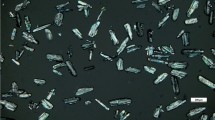Abstract
Using oxprenolol HC1 as a model drug, the effects of pH and buffer concentration on the swelling and drug release properties in cross-linked poly(methyl methacrylate-co-methacrylic acid) (PMMA/ MAA) beads have been investigated. The kinetics of swelling of such hydrophobic anionic gel beads from the dehydrated state appear to be governed primarily by a diffusion– ionization process which becomes more ionization-controlled at higher buffer concentrations. Within the range of ionic compositions studied, the swelling rate increases and the initial swelling/ionization front penetration becomes increasingly linear in time with increasing pH or buffer concentration of the swelling medium. The corresponding swelling bead diameter appears to reach an equilibrium value as soon as the penetrating ionization fronts meet at the center, suggesting a swelling equilibrium in the ionized shell due to rapid mechanical readjustment in the gel phase. At oxprenolol loading levels up to 15%, both the transient drug release and swelling bead diameter exhibit extended quasi-linear regions despite the inherent limitation of decreasing surface area at the penetrating front in the spherical geometry. In addition, both the drug release and the dimensional changes reach completion when the penetrating ionization fronts meet at the center, suggesting a true swelling-controlled drug release behavior.
Similar content being viewed by others
REFERENCES
W. Kuhn, B. Hargitay, A. Katchalsky, and H. Eisenberg. Reversible dilation and contraction by changing the state of ionization of high-polymer acid networks. Nature 165:514–516 (1950).
F. Helfferich. Ion Exchange, McGraw-Hill, New York, 1962.
S. H. Gehrke, G. P. Andrews, and E. L. Cussler. Chemical aspects of gel extraction. Chem. Eng. Sci. 41:2153–2160 (1986).
J. H. Kou, G. L. Amidon, and P. I. Lee. pH-dependent swelling and solute diffusion characteristics of poly(hydroxyethyl methacrylate-co-methacrylic acid) hydrogels. Pharm. Res. 5:592–597 (1988).
L. Brannon-Peppas and N. A. Peppas, Solute and penetrant diffusion in swellable polymers. IX. The mechanisms of drug release from pH-sensitive swelling-controlled systems. J. Control. Release 8:267–274 (1989).
P. E. Grimshaw, J. H. Nussbaum, A. J. Grodzinsky, and M. L. Yarmush. Kinetics of electrically and chemically induced swelling in polyelectrolyte gels. J. Chem. Phys. 93:4462–4472 (1990).
S. R. Eisenberg and A. J. Grodzinsky. The kinetics of chemically induced non-equilibrium swelling of articular cartilage and corneal stroma. J. Biomech. Eng. 109:79–89 (1987).
E. Vasheghani-Farahani, J. H. Vera, D. G. Cooper, and M. E. Weber. Swelling of ionic gels in electrolyte solutions. Ind. Eng. Chem. Res. 29:554–560 (1990).
S. H. Gehrke and E. L. Cussler. Mass transfer in pH-sensitive hydrogels. Chem. Eng. Sci. 44:559–566 (1989).
B. A. Firestone and R. A. Siegal. Dynamic pH-dependent swelling properties of a hydrophobic polyelectrolyte gel. Polym. Commun. 29:204–208 (1988).
R. A. Siegal, B. A. Firestone, I. Johannes, and J. Cornejo. Weak ionic hydrogels: Effects of pH, ionic strength, and buffer composition on swelling equilibria, kinetics, and solute release. Polym. Preprint 31:231–232 (1990).
L. Brannon-Peppas and N. A. Peppas. Equilibrium swelling behaviour of pH-sensitive hydrogels. Chem. Eng. Sci. 46:715–722 (1991).
M. H. B. Skovby and J. Kops. Preparation by suspension polymerization of porous beads for enzyme immobilization. J. Appl. Polym. Sci. 39:167–177 (1990).
P. I. Lee and C.-J. Kim. Effect of geometry on solvent front penetration in glassy polymers. J. Membr. Sci. (in press).
P. I. Lee and C.-J. Kim. Probing the mechanisms of drug release from hydrogels. J. Control. Release 16:229–236 (1991).
P. I. Lee. Kinetics of drug release from hydrogel matrices. J. Control. Release 2:277–288 (1988).
P. I. Lee. Dimensional changes during drug release from a glassy hydrogel matrix. Polym. Commun. 24:45–47 (1983).
N. L. Thomas and A. H. Windle. Transport of methanol in poly(methyl methacrylate). Polymer 19:255–265 (1978).
Author information
Authors and Affiliations
Rights and permissions
About this article
Cite this article
Kim, CJ., Lee, P.I. Hydrophobic Anionic Gel Beads for Swelling-Controlled Drug Delivery. Pharm Res 9, 195–199 (1992). https://doi.org/10.1023/A:1018929205254
Issue Date:
DOI: https://doi.org/10.1023/A:1018929205254




